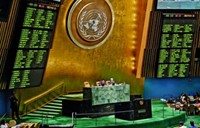Advertisement
Grab your lab coat. Let's get started
Welcome!
Welcome!
Create an account below to get 6 C&EN articles per month, receive newsletters and more - all free.
It seems this is your first time logging in online. Please enter the following information to continue.
As an ACS member you automatically get access to this site. All we need is few more details to create your reading experience.
Not you? Sign in with a different account.
Not you? Sign in with a different account.
ERROR 1
ERROR 1
ERROR 2
ERROR 2
ERROR 2
ERROR 2
ERROR 2
Password and Confirm password must match.
If you have an ACS member number, please enter it here so we can link this account to your membership. (optional)
ERROR 2
ACS values your privacy. By submitting your information, you are gaining access to C&EN and subscribing to our weekly newsletter. We use the information you provide to make your reading experience better, and we will never sell your data to third party members.
Environment
Defining WMDs
September 11, 2006
| A version of this story appeared in
Volume 84, Issue 37
The salient feature of weapons of mass destruction (WMDs) is not actually the level of destruction, but rather the persistence and indiscriminateness of destruction (C&EN, May 29, page 21). What makes WMDs worse than "conventional weapons" is that once deployed, they cannot be controlled and they continue to do damage. It is this aspect that makes WMDs subject to treaties and additional controls.
When you release a chemical weapon into the environment, you have little control over where it goes and whom it affects. It may persist for some time, travel by wind and water, and cause harm far from the intended targets; it is likewise with radiological weapons and even more so with biological and nuclear weapons. With an explosive, conversely, you choose a location and a size of bomb, and the damages are relatively predictable and are done.
There are borderline cases: Use of conventional explosives in such a way as to create a firestorm, as in Dresden or Tokyo in World War II, results in a WMD-like effect. The use of depleted uranium in conventional weaponry could also be considered a WMD if it is shown to be a cause of persistent and indiscriminate health damage. Conversely, tear gas and similar nonlethal chemical weapons need not be classified as WMDs or included in treaties. Cyber attacks, while they can be persistent, indiscriminate, and disruptive, are a different arena entirely and need to be handled separately.
Under this logic, defining WMDs as a chemical/biological/radiological/nuclear (CBRN) or nuclear/biological/chemical (NBC) weapon seems to be a logical and rational approach.
Philip Boncer
San Diego
I am sorry, but C&EN missed an important point about WMDs of interest to ACS members: tear agents such as CS (2-chlorobenzalmalononitrile) and CN (chloroacetophenone) are chemical weapons. What distinguishes them from WMDs? The fact that they're not intended to be used to lethal effect? Waco argues otherwise. That brings up the question of whether incendiaries such as napalm are WMDs, and if not, why not?
Should members have ethical concerns about assisting the manufacture of these agents or their precursors?
Robert Redelmeier
Houston




Join the conversation
Contact the reporter
Submit a Letter to the Editor for publication
Engage with us on Twitter